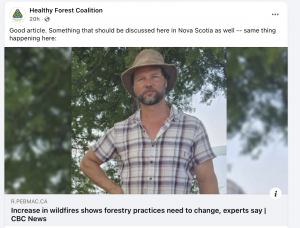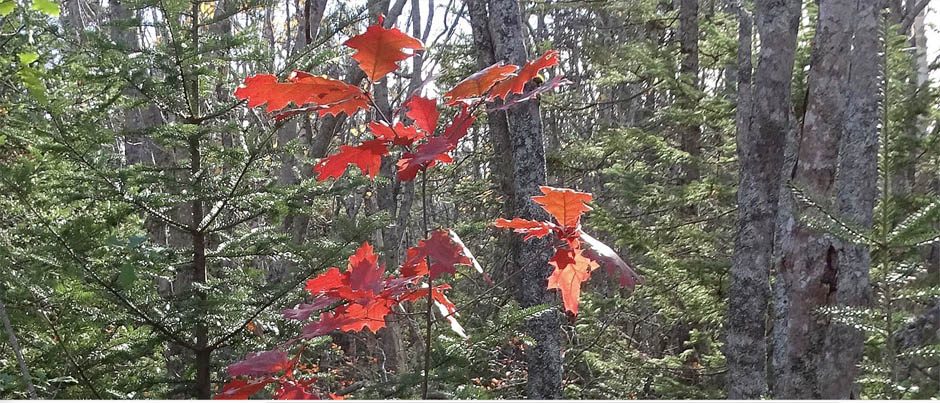NAVIGATION. This page is a subpage of In the News – Wildfire/Extreme Weather on the website Nova Scotia Forest Matters (www.nsforestmatters.ca)

Image from post about the article on Healthy Forest Coalition website, Aug 31, 2025. It elicited a quick response from Steve Freeman, Human Resource Executive at of Freeman Lumber.
Extracts from the article, posted by CBC on Aug 29, 2025:
– Increase in wildfires shows forestry practices need to change, experts say
Katherine Del Salto · CBC News.
Extracts: Subtitle: “Researcher, environmentalist say softwood monocultures, such as tree farms, increase the risk of fire” From the text.”More than 300 wildfires have been recorded in New Brunswick so far this year, up from 226 in 2024. Even more striking is the amount of land that has been burned. Last year, it was about 187 hectares. This year, it’s already more than 2,506 hectares. Anthony Taylor, a professor of forest ecology at the University of New Brunswick, said practices that promote the cultivation of only softwood trees, such as spruce and pine — known as monoculture — might be making our forests more vulnerable to fires. “If you have a landscape like New Brunswick, and you are doing more spraying [of herbicides] to promote more conifers, in essence you’re creating a landscape that’s more vulnerable to fire if you had the right weather,” said Taylor. Diverse forests, with mixed conifer and hardwood species, better resist fires, according to Taylor. He explained that conifer woods are more vulnerable to fires because chemicals within them make them combust easier than other types of trees…According to the 2023 State of the Forest Report, released by the provincial government in an effort to provide information on how Crown forests are managed, 68 per cent of trees in the province are softwood trees, while the remaining are hardwoods…
Environmental group wants more diverse forests
…[spokesperson for the Department of Natural Resources] Kilfoil said the Crown land forest strategy in New Brunswick includes reducing “forest fuels” by thinning the forest so “crowded and dead trees” are not left standing. She said the strategy also includes “new elements to preserve species diversity,” which includes “hardwood and mixed wood forests, which burn at lower intensity.” Kilfoil did not specify what those new elements are. Gingras [Beverly Gingras, executive director of the Conservation Council of New Brunswick] points to forest management practices like selection harvesting, which promotes forest diversity by keeping some hardwoods. She said it not only helps to protect plantations of softwood, but also protects nearby communities. “I think it behooves the government forest industry to really think about how to do forest management practise to adapt to climate change,” she said. “[To] think about how to make these communities and forests more resilient to climate change and forest fires.”
COMMENTS ON THE HEALTHY FOREST COALITION FACEBOOK PAGE
Steve Freeman
I think protecting more land and reducing access for firefighters to stop it early is completely irresponsible. That is the exact reason this current fire in West Dalhousie wasn’t stopped quickly. My grandfather was a research scientist and environmentalist. He called them” parks and neglected areas”
Once the Hemlock in Kedji and the Tobiatic dry out, die, fall over and create fire load we are in for a real disaster. No access and no plan. One lightning strike and 500,000 acres are at risk.
Forest management is not the problem. It’s the answer.
In Western Nova Scotia we work in mixed wood stands and have mixed wood regeneration. The “monoculture” and high production forests are such a small portion of what is done today.
I support the Lahey model but even protected areas need to be managed with a very light touch as they are in other jurisdictions in the world (including Canada).
We need to work with the forest we have for practical solutions not aspire to fantasy of endless old growth in 100 years.
We all love trees and forests but the Healthy Forest Coalition doesn’t seem to support them with practical or reasonable solutions in my opinion. I hope to be corrected….
Healthy Forest Coalition responds to Steve Freeman
Steve Freeman, glad that there is some agreement and both you and our organization supoort treating our best Hemlock stands for HWA. There is large distinction to be made between managing for an invasive insect and extracting wood fibre for profit. You have also proven the point that managing for invasive species was permitted within a Protected Area, so they are not simply abandoned, but managed very carefully.
Bev Wigney responds to Steve Freeman
When I have looked at that area where the fire occurred, there are logging roads right into that area. That’s true of many areas of forest already. And, we already know that a very large percentage of fires are human-caused. Opening up greater access into protected areas is just asking for trouble.
Steve Freeman responds to Bev Wigney
how many forest fire have you fought. My company and our contractors have been there since the beginning, working tirelessly to fight it.
I haven’t fought this one personally but it’s not good. Access is essential.
The fires in Shelburne we impossible to fight because access was a problem.
Have you ever had to tell a homeowner there is nothing we can do. I have and it isn’t something you ever want to do.
Healthy Forest Coalition responds to Steve Freeman (re his repsonse to Bev W)
The work you have done to fight forest fires is commendable. Simply put, if folks do not support the existence of Protected Areas they do not support the Lahey Report and the triad model of forestry. The HFC accepts that High-Production Foresty is part of this model, but it must occur in sites that do not possess above average ecological or cultural value. The Wabanki-Acadian forest ecosystem is naturally fire-resistent, and the number 1 cause of fires, by a longshot, in Nova Scotia is human behaviour. This means that are two best tools are to change human behaviour and restore our natural, healthy forests.
Steve Freeman respomds…
I do support protecting forests. We have protected areas on our own land base (not formally designated). The idea that you shouldn’t intervene when there is a foreign insect destroying our most precious forests is irresponsible and out of touch with reality.
My favourite forest in Nova Scotia is the Sporting Lake nature reserve. It is spectacular and I was so happy it’s been treated but the idea that our precious eastern hemlock (we don’t have time to treat them all) should be left to create fire load isn’t right and is irresponsible.
You can support protected areas and believe they should be managed in extreme circumstances. The hemlock woolly adelgid isn’t a natural disturbance and requires intervention now.
The last thing I want to be doing is building dozer guards in the parks and protected areas but it’s pretty much a certainty in the next 20 years.
Leaving a forest alone is not protecting it.
HFC back to Steve F…
glad that there is some agreement and both you and our organization supoort treating our best Hemlock stands for HWA. There is large distinction to be made between managing for an invasive insect and extracting wood fibre for profit. You have also proven the point that managing for invasive species was permitted within a Protected Area, so they are not simply abandoned, but managed very carefully.
Steve F to HFC…
if you can find profit in sawing Hemlock please let us know. We only saw it as a last resort. Too many splits and way too much shake. Only 60% makes a high enough grade to sell as premium…
It makes beautiful Timbers but the market is small and not overly profitable.
Related comment by Donna Crossland, writer for NSFM:This is a great article lead by one of our very own…
Re: “”Kilfoil said the Crown land forest strategy in New Brunswick includes reducing “forest fuels” by thinning the forest so “crowded and dead trees” are not left standing”: She over-looks that most forests will naturally thin themselves. They do not need forestry to remove small trees and DEAD WOOD, oh my! The trouble is that most forests are very young at this point. They just need more time to thin themselves. With the increase in growth rates we are seeing (which should be reflected in the Permanent Sample Plots across NS and NB), perhaps forests will thin themselves more quickly now- the “stem exclusion phase”, as it is called. Waiting for nature to do it doesn’t leave wheel ruts and extraction routes, burn more fossil fuels, generally just running amuck….
The pressure mounted by industry to thin protected areas forests has been high for the past couple of years. They’ve gotten some traction apparently. It’s very troubling.
—-END OF COMMENTS AS OF SEP 1, 2025 7:29 AM—-
